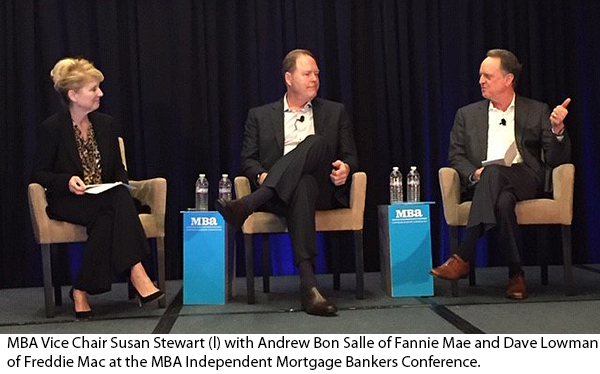
GSEs Push for Greater Efficiencies in Mortgage Process
SAN FRANCISCO–These are not quiet times for Fannie Mae and Freddie Mac.
Both government-sponsored enterprises are undergoing enormous structural changes. The CEOs of both GSEs (Tim Mayopoulus at Fannie Mae, Donald Layton at Freddie Mac) have left or are leaving, with Hugh Frater taking over at Fannie Mae as interim CEO and Freddie Mac engaging in a search process for a new CEO. The GSEs’ federal regulator, the Federal Housing Finance Agency, has also seen changes at the top with Director Mel Watt leaving in January and the Trump Administration nominating Mark Calabria to replace him (with Joseph Otting serving as acting director).
 And efforts to reform the secondary mortgage finance system appear to have renewed vigor this year after more than 10 years of Fannie Mae and Freddie Mac under conservatorship. On Friday, Senate Banking Committee Chairman Mike Crapo, R-Idaho, outlined a framework for legislative fixes to the housing finance system (https://www.banking.senate.gov/imo/media/doc/Housing%20Reform%20Outline.pdf).
And efforts to reform the secondary mortgage finance system appear to have renewed vigor this year after more than 10 years of Fannie Mae and Freddie Mac under conservatorship. On Friday, Senate Banking Committee Chairman Mike Crapo, R-Idaho, outlined a framework for legislative fixes to the housing finance system (https://www.banking.senate.gov/imo/media/doc/Housing%20Reform%20Outline.pdf).
“The GSEs play a vital role in the mortgage market,” said Susan Stewart, 2019 MBA Vice Chairman and CEO of SWBC Mortgage, San Antonio, Texas, here at the recent MBA Independent Mortgage Bankers Conference. “Liquidity is challenging the profitability of independent mortgage banks, which makes our relationship with the GSEs more important than ever.”
Andrew Bon Salle, Executive Vice President of Single–Family Business, Fannie Mae, noted IMBs provide Fannie Mae with 60 percent of its business. “We know it’s tough in the primary market right now and we know you want to see reduced costs and reduced risk,” he said here at the Mortgage Bankers Association’s Independent Mortgage Bankers Conference.
Bon Salle noted technology continues to play a huge focus at Fannie Mae. “We think there’s still a lot of efficiencies to be realized,” he said.
Bon Salle said profitability will play a huge role at Fannie Mae in 2019 as interest rates rise. “We see some headwinds, particularly with housing supply, and we see a slight decrease in mortgage originations. As everyone wants their share of the pie, we see margin compression showing up in a number of ways.”
Dave Lowman, Executive Vice President of Single-Family Business with Freddie Mac, said liquidity is not the issue. “The issue is about margins, and having been in this business for 35 years and knowing the cyclical nature of the business, we have to see the margin issue straighten itself out,” he said.
Lowman said Freddie Mac takes issue with a proposed Consumer Financial Protection Bureau rule that creates a “QM patch” for Qualified Mortgages. These proposed rule includes a debt-to-income ratio cap of no more than 43 percent, or in the alternative, eligibility for Fannie Mae and Freddie Mac, FHA or other government programs.
“I know there is talk about reducing the GSEs’ footprint, but reducing the QM patch is not the way to do it,” Lowman said. “I’m not convinced that there is enough private capital out there to supplement what we do in the marketplace.”
Lowman and Bon Salle said their respective GSEs remain committed to meeting their affordable housing goals. “We need to be more involved at the local level,” Lowman said. “We all need to work together on this–there is no silver bullet; if there was, we would have solved this issue a long time ago.”
Lowman said Freddie Mac will continue to not purchase PACE loans. “I don’t understand why PACE loans are allowable,” he said. “I don’t see us resolving this issue anytime soon.”
“We’ve tried to work with that industry,” Bon Salle said. “We’ve not found a way to resolve this issue. We have our own competing programs [Homestar program] that wsde think offer a safer alternative to PACE loans.
“We’ve fundamentally changed the face of servicing Freddie Mac loans in the past few years,” Lowman said. “But there are still too many one-offs that can be made more efficient.”
